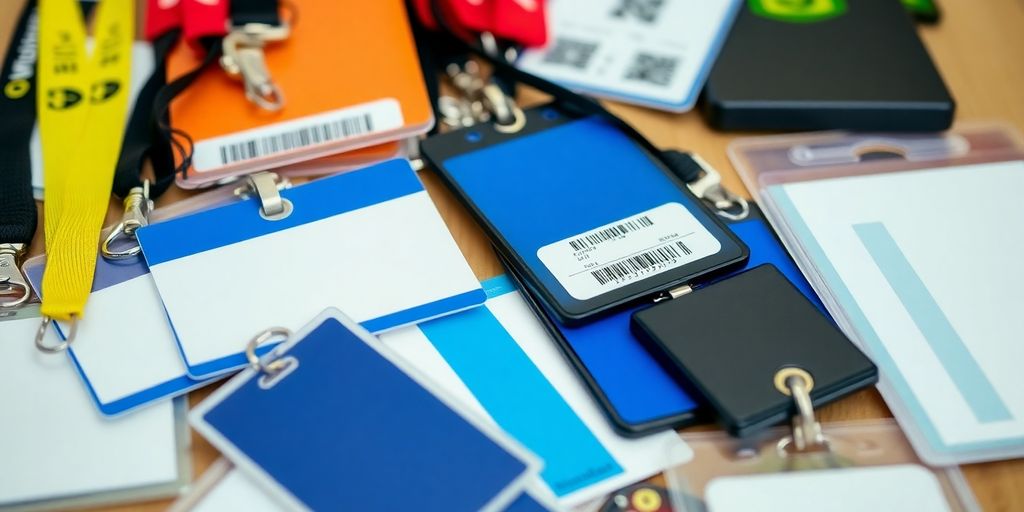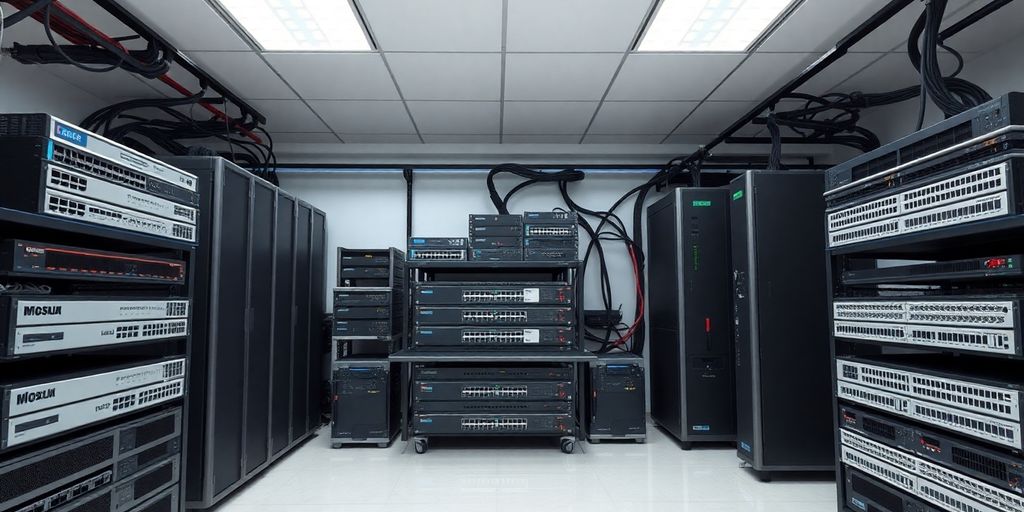Ever thought about how those little ID badges keep a place secure? Access control badging supplies are at the heart of it all. Whether it’s a corporate office or a school, these badges do more than just hang around your neck. They’re a key part of security, making sure only the right folks get through the door. From basic ID cards to high-tech digital badges, there’s a lot to consider when picking the right one for your needs. Let’s break it down and see what’s what in the world of access control badging.
Key Takeaways
- Access control badges are essential for secure entry into buildings.
- There are various types of badges, including RFID and biometric options.
- Design and customization of badges can enhance security and user convenience.
- Effective badge management involves proper issuance, tracking, and disposal.
- Advanced technologies like mobile badges are shaping the future of access control.
Understanding Access Control Badging Supplies
Key Components of Badging Systems
When setting up an access control system, understanding its core components is crucial. At its heart, a badging system includes ID badges, badge readers, and a central database. ID badges serve as the primary means of identification and can contain information like a photo, name, or unique ID number. Badge readers are the devices that scan these ID badges to verify access rights. Finally, the central database is where all the data is stored, including user credentials and access logs.
- ID Badges: These can be simple plastic cards or advanced smart cards embedded with RFID chips.
- Badge Readers: Devices that read the data on the badges, which can be magnetic stripe readers, barcode scanners, or RFID readers.
- Central Database: This system manages the data, logs access events, and controls permissions.
Types of Access Control Badges
Access control badges come in various types, each suited for different security needs. Proximity cards are popular for their ease of use, allowing users to simply wave the card near a reader. RFID tags offer more advanced security features, often used in high-security environments. Magnetic stripe cards are another option, though they are more prone to wear and tear.
- Proximity Cards: Easy to use, typically used in office environments.
- RFID Tags: Offer enhanced security and can store more information.
- Magnetic Stripe Cards: Commonly used but less durable.
Importance of Badge Design
The design of an access control badge is more than just aesthetics; it’s about functionality and security. A well-designed badge should be easily recognizable and difficult to duplicate. Incorporating elements like holographic overlays or UV printing can add layers of security, making it harder for unauthorized individuals to create counterfeit badges.
A badge is not just a piece of plastic; it’s a gateway to your facility. Ensuring its design is both functional and secure is key to maintaining a safe environment.
In summary, understanding the components, types, and design of access control badges is essential for creating a secure and efficient system. Whether you’re using basic ID cards or advanced RFID technology, each element plays a crucial role in protecting your premises.
Choosing the Right Badge for Your Security Needs
Factors to Consider in Badge Selection
Picking the right badge isn’t just about aesthetics; it’s about practicality and security. The badge you choose needs to align with your security requirements and the environment in which it will be used. Consider the following factors:
- Security Level: Determine the level of security needed. High-security areas may require badges with RFID or biometric capabilities, while lower-security areas might manage with simpler magnetic stripe cards.
- Durability: Think about how long the badge needs to last. If it’s for temporary use, a less durable material might suffice. For long-term use, invest in durable materials that withstand wear and tear.
- Visibility: Ensure that badges are easily visible to security personnel. This might involve using bright colors or clear labeling for easy identification.
Customizing Badges for Different Users
One size doesn’t fit all when it comes to badges. Different users have different needs, and your badge system should reflect that. Customization options include:
- Role-Based Design: Tailor badges to reflect the user’s role within the organization. For example, different colors for staff, visitors, and contractors can help quickly identify access levels.
- Personalization: Include personal details such as name, photo, and department to enhance security and accountability.
- Access Levels: Customize the access permissions encoded on the badge to limit or grant access to specific areas as required.
Balancing Security and Convenience
In the quest for security, convenience often takes a back seat. However, the right badge system should strike a balance between the two. Here’s how you can manage:
- Ease of Use: Make sure badges are user-friendly. Complicated systems can lead to user errors and frustration.
- Integration: Ensure the badge system integrates smoothly with existing security protocols and systems.
- Flexibility: Opt for a system that can easily adjust to changing security needs or user roles without requiring a complete overhaul.
Balancing security and convenience is a delicate act. While it’s vital to maintain strict security measures, the system should not be so cumbersome that it hinders daily operations. A well-thought-out badge system can provide both security and ease of use, making it an invaluable part of your security strategy.
When selecting a badge, consider the eBadge Trusted Worker Program (TWP) for a streamlined application process, especially in high-security environments like aviation.
Implementing Effective Badge Management Systems

Issuing and Tracking Badges
Managing badges effectively starts with a robust issuance and tracking system. Keeping a digital record of every badge issued is crucial. This involves using a visitor management system to log details about each badge holder, which can assist in accountability and help track who enters and exits your premises. This is especially handy for temporary badges, ensuring you know who had access and when.
A good system will also include real-time logging, which can be vital during emergencies or evacuations. This means supervisors can quickly account for all personnel, improving safety and efficiency.
Integrating with Existing Security Systems
To make the most of your badge management, it’s essential to integrate these systems with existing security measures. This might mean linking badge readers with security cameras or alarms. Such integration can enhance monitoring and provide a comprehensive view of security across your facility.
Consider the types of badges you’re using. RFID badges, for instance, can offer contactless access and can be easily integrated with other tech solutions. This integration helps in creating a seamless security environment and can alert security personnel to any unauthorized access attempts.
Training Staff on Badge Protocols
Your security staff are the frontline defenders when it comes to badge management. Regular training sessions are vital. They should know how to issue, inspect, and handle badges properly, and understand the importance of verifying identities.
Training should cover the latest security trends and technologies, like RFID and biometric systems, to ensure staff are up-to-date with current best practices. This knowledge not only helps in maintaining security but also empowers staff to respond effectively to any security breaches.
Effective badge management isn’t just about having the right technology; it’s about ensuring everyone involved understands their role and the importance of maintaining security protocols.
Enhancing Security with Advanced Badge Technologies
Exploring RFID and Biometric Options
In today’s fast-paced world, security is more important than ever. RFID (Radio Frequency Identification) and biometric technologies are at the forefront of modern security solutions. RFID badges use electromagnetic fields to automatically identify and track tags attached to objects. This technology is widely used for access control because it’s fast and reliable. On the other hand, biometric systems use unique physical characteristics, like fingerprints or facial recognition, to verify identity. These systems are highly secure because they are nearly impossible to fake.
- RFID Badges:
- Biometric Systems:
Benefits of Digital and Mobile Badges
Digital and mobile badges represent the next step in badge technology. These badges can be stored on smartphones, which most people carry with them all the time. This means no more worrying about forgetting or losing a physical badge. Mobile badges are not only convenient but also offer enhanced security features like encryption and remote deactivation.
- Convenience: No need for physical cards.
- Security: Encrypted data and remote management.
- Flexibility: Easily updated and customized.
Future Trends in Badge Technology
The future of badge technology is bright, with many exciting developments on the horizon. One trend is the integration of AI, which can analyze patterns and detect anomalies in badge usage. Another is the use of blockchain for secure, tamper-proof records of badge transactions. As these technologies evolve, they will provide even more robust security solutions.
As technology continues to advance, the way we think about security must also evolve. Embracing new badge technologies is not just about staying current; it’s about safeguarding our future.
Maintaining and Securing Badge Supplies
Best Practices for Badge Storage
Keeping badge supplies in good condition starts with proper storage. Here are a few tips to ensure your badges stay in top shape:
- Environment Control: Store badges in a cool, dry place to prevent warping or fading. Avoid areas with direct sunlight or high humidity.
- Organized Inventory: Maintain an organized system to track badge stock levels. This prevents shortages and ensures you always have enough on hand.
- Secure Access: Limit access to badge supplies to authorized personnel only. This reduces the risk of theft or unauthorized use.
Ensuring Badge Durability and Longevity
Badges are often subject to daily wear and tear, so it’s important to choose materials that can withstand frequent use. Consider these factors:
- Material Quality: Opt for high-quality, durable materials that resist scratching and bending.
- Protective Coatings: Use badges with protective coatings to shield against moisture and UV damage.
- Regular Maintenance: Clean badges regularly and inspect them for signs of damage, replacing any that are compromised.
Secure Disposal of Expired Badges
Old and expired badges pose a security risk if not disposed of properly. Here’s how to handle them:
- Return and Collect: Implement a system for collecting expired badges from users.
- Secure Destruction: Shred or incinerate badges to prevent them from being reused or falling into the wrong hands.
- Document Disposal: Keep a record of disposed badges to maintain accountability and ensure no badge is unaccounted for.
Proper management of badge supplies not only enhances security but also ensures efficiency in access control operations. By following these guidelines, organizations can maintain a robust security posture while managing their badge inventories effectively.
Evaluating the Impact of Badge Systems on Security

Measuring Security Improvements
When it comes to security, badge systems can be a game-changer. They help track who goes where and when, making it easier to spot any funny business. With the ability to deactivate lost or stolen badges, security is beefed up significantly. Businesses can keep tabs on attendance and movement, which is super handy for spotting unusual patterns.
Here’s a quick look at some key benefits:
- Improved Security: Stops unauthorized folks from getting in.
- Enhanced Visibility: Keeps a record of entries and exits.
- Increased Efficiency: Cuts down on manual record keeping.
Identifying Potential Weaknesses
Of course, no system is perfect. Badge systems can sometimes fail if a badge gets damaged or if there’s interference from other signals. Plus, they rely on electricity, so if the power goes out, you might be in trouble. It’s also worth noting that some older systems might have security holes, which could be a problem if hackers get involved.
Consider these challenges:
- Reliability Issues: Damaged badges might not work.
- Power Dependency: Needs electricity to function.
- Security Risks: Older systems might be vulnerable.
Continuous Improvement Strategies
To keep your badge system in top shape, regular updates and maintenance are key. This includes checking for any security patches and making sure everything’s running smoothly. Training staff on the ins and outs of the system can also help prevent mishaps.
- Regular System Updates
- Staff Training Sessions
- Routine Maintenance Checks
Keeping up with the latest in badge technology can make a huge difference. It’s all about staying ahead of potential threats and making sure your security measures are up to date.
Incorporating gamification in cybersecurity can also boost engagement and productivity, making it a smart addition to any security strategy.
Wrapping It Up
So, there you have it. Access control badging supplies are more than just plastic cards and lanyards. They’re a key part of keeping your space secure, whether it’s a bustling office or a quiet school. By choosing the right supplies and keeping up with the latest trends, you can make sure your security measures are up to snuff. Remember, it’s not just about keeping people out, but also about knowing who’s in. With the right setup, you’ll have peace of mind knowing your facility is safe and sound. Thanks for sticking around, and here’s to a safer tomorrow!
Frequently Asked Questions
What are access control badges?
Access control badges are special cards or tags that help identify people and allow them to enter certain areas. They are used to make sure only the right people can get into places like offices or schools.
How do badge systems work?
Badge systems work by using a badge reader to check the information on a badge. If the badge has the right information, the system unlocks the door or gate for the person to go through.
Why is badge design important?
Badge design is important because it helps people quickly know who can go where. A good design makes it easy to see if a person should be in a certain area or not.
What should I consider when choosing a badge?
When picking a badge, think about how secure it needs to be, who will use it, and how easy it is to customize. You want a badge that fits your security needs and is easy for people to use.
How can badges improve security?
Badges improve security by making sure only people with the right badge can get into certain areas. They help keep track of who goes where and make it harder for strangers to enter.
What is the future of badge technology?
The future of badge technology includes using things like smartphones and digital badges. These new technologies make it even easier and safer to manage who gets into different places.



